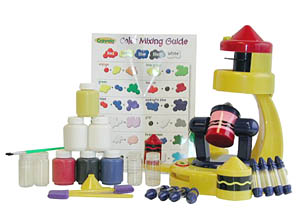Crayola Paint Mixer
Mix your own paint, comes with color mixing guide.
 Children mix their own colors of Crayola paint. Fun mixing action teaches children about colors. No-mess design. Complete with Crayola paints and a recipe guide for many Crayola colors. Painting accessories included.
Children mix their own colors of Crayola paint. Fun mixing action teaches children about colors. No-mess design. Complete with Crayola paints and a recipe guide for many Crayola colors. Painting accessories included.
Mixing paint is a captivating and hands-on way for children to dive into the fascinating world of color theory. Through experimentation and exploration, this activity provides valuable insights into the relationships between colors and the principles that govern them. Here's how mixing paint teaches children about color theory:
Primary Colors: Children start by learning about the primary colors—red, blue, and yellow. These fundamental colors cannot be created by mixing other colors and serve as the building blocks for all other hues.
Secondary Colors: By blending primary colors, children discover the creation of secondary colors—orange, green, and purple. This process showcases the art of color mixing and introduces the concept of complementary pairs.
Color Mixing Rules: As children experiment with mixing paint, they observe that combining different amounts of primary colors results in a spectrum of secondary and intermediate colors. They grasp the concept that mixing all three primary colors produces neutral tones.
Color Relationships: Children witness how colors interact when mixed, leading to discussions about warm and cool colors, color harmonies, and the visual impact of certain combinations.
Shades and Tints: Beyond creating new colors, children explore the creation of shades (by adding black) and tints (by adding white), deepening their understanding of color variations and possibilities.
Color Wheel Exploration: Through hands-on paint mixing, children create their own color wheel, gaining firsthand experience of the relationships between primary, secondary, and intermediate colors.
Visual Effects: Mixing complementary colors demonstrates contrast and visual impact. Children observe how complementary pairs intensify when placed side by side, enhancing their grasp of color dynamics.
Color Moods: Children begin to associate colors with specific emotions and moods as they explore the psychological effects of different color combinations in their artwork.
Problem Solving: Paint mixing encourages critical thinking as children determine how to achieve specific colors or shades, honing their problem-solving skills and encouraging experimentation.
Creative Freedom: Learning about color theory through paint mixing empowers children to make informed choices when selecting colors for their art projects, fostering independent decision-making.
Artistic Expression: Understanding color theory equips children with the tools to convey their thoughts, feelings, and stories more effectively through color choices in their artwork.
Scientific Exploration: Mixing paint introduces scientific concepts such as pigments, absorption, and reflection of light, creating a bridge between art and science.
Continuous Learning: As children gain confidence in mixing colors, they become more open to exploring more advanced color theories, such as analogous, triadic, and split-complementary color schemes.
Mixing paint provides children with a tangible and engaging introduction to color theory. This hands-on approach allows them to grasp the magic of color relationships, experiment with creativity, and develop a deeper appreciation for the vibrant spectrum that surrounds them.
